Comments / Questions (136)
![]() Margaretha Lagetdahl wrote:
Margaretha Lagetdahl wrote:
I am NOT a scammer / just trying to finish my project sweater Ice Island. Your instructions are sometimes hard to understand as the differ from other instructions. And I would prefer them in Swedish. I am 88 years old and knitting is not the same as 50 years ago. This sweater was to be s Christmas gift for my grandchild
16.12.2025 - 16:05
![]() Margaretha Lagerdahl wrote:
Margaretha Lagerdahl wrote:
Jag blir galen på det här mönstret. Halsen: Jag har nu 142 maskor inkl maskorna från tråd mitt fram. Vad menas med att sticka fram och tillbaks och var skall ytterligare minskningar göras? Skall man fortsätta sticka raglan?? Hurdå? Tröjan skulle vara klar till jul !!!! Blir den inte p g a dålig beskrivning
15.12.2025 - 21:18
![]() Jo wrote:
Jo wrote:
I am very confused. I’ve only just started, and the ribbing does not make sense to me. I’ve never had decreases in ribbing so that’s new, but more so the stitch decreases do not add up to the stitch count I am expected to have at the end of the ribbing. According to my math the decreases should bring me from 304 to 262, not 270. And on top of that, the pattern does not account for the stitches that were decreases the previous row. What am I doing wrong?
14.12.2025 - 03:28DROPS Design answered:
Hi Jo, When working the first part of the ribbing with A.1 - A.3, you only repeat the first 2 rows in A.2 and A.3 (so there are no decreases and you should still have 304 stitches). On the next round, you decrease 6 + 1 + 2 + 1 + 13 + 1 + 2 + 1 + 7 = 34 decreased stitches. 304 - 34 = 270. Hope this helps. Regards, Drops Team.
15.12.2025 - 07:22
![]() Terri wrote:
Terri wrote:
I’m not sure I did the bind off around the neck correctly. Should I be picking up any stitches around the neck? I have 104 stitches from decreases and 32 from front neck pattern says knit142 but that would only leave 6 stitches to pick up and I have a bigger gap than that. Was I supposed to bind off 3 stitches at the beginning of every row once I put the 32 neck stitches on their thread?
11.12.2025 - 21:33DROPS Design answered:
Dear Terri, in 2nd size you have slipped the middle 32 sts for neck and cast off on each side of neck: 2 sts 1 time and 1 st 1 time = 3 sts on each side = 6 sts in total + the 104 sts remaining from yoke = 32+6+104=142 sts. Happy knitting!
12.12.2025 - 08:06
![]() Serafina wrote:
Serafina wrote:
Mitä seuraava katkelma tarkoittaa: ”Päätä SAMALLA pääntien kummastakin reunasta joka 2.kerros: 2 silmukkaa kerran ja 1 silmukka 1-1-1-2-2-2 kertaa.”? Pitääkö siis joka 2. kierros kaventaa 3 silmukkaa kummastakin reunasta jos neulon L kokoa? Ja onko nämä siis putkeen? Ja millainen kavennus on kyseessä? Ylivetokavennus vai voinko neuloa kaksi yhteen? Kiitos avustanne!
11.12.2025 - 20:03DROPS Design answered:
Hei, päätä aluksi kummastakin reunasta joka 2.kerros 2 silmukkaa (eli neulo 2 kerrosta ja päätä kummankin kerroksen alusta 2 silmukkaa). Päätä sitten 2 seuraavan kerroksen alusta vielä 1 silmukka. Silmukat päätetään, eli neulo aluksi 2 silmukkaa ja vedä sitten ensimmäiseksi neulottu silmukka toisen yli.
12.12.2025 - 16:39
![]() Serafina wrote:
Serafina wrote:
Raglankavennuksia tehdessä onko se siis 2 silmukkaa neulottu oikein molemmin puolin hihan ja etu-/takakappaleen rajakohtaa? Eli siis yhteensä 4 oikein neulottu silmukkaa per hihan ja etu-/takakappaleen rajakohtaa vai vaan 1 silmukka molemmin puolin eli 2 silmukkaa yhteensä?
07.12.2025 - 15:16DROPS Design answered:
Hei, jokaisessa rajakohdassa on 2 oikeaa silmukkaa ja raglankavennukset tehdään näiden 2 silmukan kummallakin puolella.
09.12.2025 - 16:23
![]() Margaretha wrote:
Margaretha wrote:
Jag kan inte fortsätta stickningen när det bara är 25 cm kvar! Fortsätter man minska efter det att mosstickningen är slut ca 10 -15 cm efter ärmhålen? Så fruktansvärt dåligt mönster. Är van stickerska men detta har varit så dåligt. Men hag måste ju avsluta projektet
03.12.2025 - 17:52DROPS Design answered:
Hei Margaretha. Ta en titt på vårt svar gitt til deg tidligere idag (08/12/25). mvh DROPS Design
08.12.2025 - 13:03
![]() Terri wrote:
Terri wrote:
I am on the neck portion of pattern and don’t understand after I place stitches on thread . Work to beginning and start from wrong side and continue pattern back and forth?
02.12.2025 - 13:22DROPS Design answered:
Dear Terri, after you have slipped the middle stitches on front piece on a thread, continue the round just as before, decreasing and working pattern just as before, then at the end of the round, instead of continuing the next round, cut the yarn. Slip the stitches to the stitches on the thread onto right needle without workign them so that you can now start working in rows from neck on one side of front piece to the other side of front piece, work now back and forth alternately from RS and from WS decreasing for raglan and casting off for neck as stated. Happy knitting!
02.12.2025 - 17:24
![]() Margaretha Lagerdahl wrote:
Margaretha Lagerdahl wrote:
När Mosstickningen "tar slut" efter raglanminskningar hur gör jag med mönsterstickningen? ? Fortsätter minskningar på både vänsteroch höger sida om ärmen. Finns varken bilder som förklarar eller relevant text. Väldigt otydligt skrivet
30.11.2025 - 22:20DROPS Design answered:
Hei Margaretha. Øverst i oppskriften står det diverse informasjon man trenger å vite før man starter å strikke. Der står det hvordan man strikker RAGLAN, både fra retten og vrangen og før og etter merketråden. I selve oppskriften og under RAGLAN står det hvor mange ganger det skal felles i den størrelsen du strikker. Det er også beskrevet hvor 4 merketråder skal settes = Merketrådene skal brukes når det skal felles til raglan. mvh DROPS Design
08.12.2025 - 10:28
![]() Margaretha Lagerdahl wrote:
Margaretha Lagerdahl wrote:
Har nu kommit till där raglan stickats färdigt över en del av Mosstickningen och skall bli en rätstickning över 4 maskor som bildar "sömmen" men hur minskar man mot själva grundmönstret? Förut var det en minskning på var sin sida efter en rätmaska på var sin sida om markören. Jobbigt mönster överhuvudtaget. Hade nog varit lättare med fram/bakstycke som sys ihop istället för rundstickat. Tacksam för snabbt svar då tröjan förhoppningsvis skulle bli julklapp!
28.11.2025 - 09:55DROPS Design answered:
Hei Margaretha. Du strikker etter diagrammene og feller som før, du vil da få en rett maske med felling, 2 rettmaske (merketråden sitter mellom disse 2) og 1 rett maske med felling (husk les forklaring til raglan felling øverst i oppskriften). Du får da en "raglanlinje" bestående av 4 rett masker. mvh DROPS Design
08.12.2025 - 09:49
Ice Island#iceislandsweater |
|||||||||||||||||||||||||||||||
 |
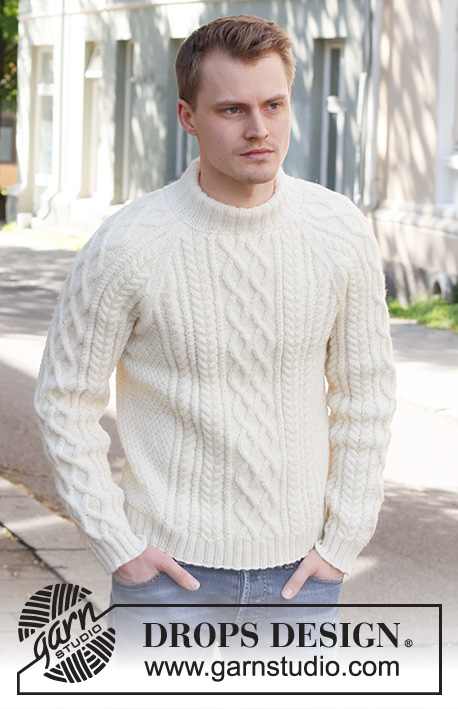 |
||||||||||||||||||||||||||||||
Knitted jumper for men in DROPS Karisma. The piece is worked with raglan, cables and double neck. Sizes S - XXXL.
DROPS 224-10 |
|||||||||||||||||||||||||||||||
|
------------------------------------------------------- EXPLANATIONS FOR THE PATTERN: ------------------------------------------------------- KNITTING TIP: In sizes XL, XXL and XXXL, there will be 4 purl stitches next to each other when A.1 is worked 2 times in width. So the rib will match under A.5/A.8, which is worked after the rib. PATTERN: See diagrams A.1 to A.10. The diagrams show all rows in the pattern from the right side. DECREASE/INCREASE TIP (evenly spaced): To work out how to decrease/increase evenly, count the number of stitches to be decreased/increased over (e.g. 23 stitches), and divide by the number of decreases/increases to be made (e.g. 6) = 3.8. In this example, decrease by knitting together approx. each 3rd and 4th stitch. When increasing, make 1 yarn over after approx. each 4th stitch. On the next round work the yarn overs twisted to avoid holes. INCREASE TIP (sleeves): Increase 2 stitches under the sleeve by making 1 yarn over on each side of the marker-stitch as follows: Work the marker-stitch (always the first stitch in A.4), 1 yarn over, pattern as far as the marker-stitch, 1 yarn over (= 2 stitches increased). On the next round work the yarn overs twisted to avoid holes. Then work the new stitches into A.9/A.10 until you have room for a complete repeat, then work the stitches in A.4. RAGLAN: Decrease to raglan on each side of the marker, in each transition between body and sleeves as follows. FROM RIGHT SIDE: AFTER THE MARKER: Knit 1, slip 1 stitch as if to knit, knit 1 and pass the slipped stitch over the knitted stitch (= 1 stitch decreased) BEFORE THE MARKER: Work until there are 3 stitches left before the marker, knit 2 together, knit 1 (= 1 stitch decreased). FROM WRONG SIDE: AFTER THE MARKER: Purl 1, purl 2 together (= 1 stitch decreased) BEFORE THE MARKER: Work until there are 3 stitches left before the marker, purl 2 twisted together, purl 1 (= 1 stitch decreased). ------------------------------------------------------- START THE PIECE HERE: ------------------------------------------------------- JUMPER – SHORT OVERVIEW OF THE PIECE: The body is worked in the round with circular needle as far as the armholes. The sleeves are worked in the round with double pointed needles/short circular needle, bottom up. The body and sleeves are placed on the same circular needle and the yoke worked, decreasing to raglan at the same time. Stiches are cast off for the neck mid-front and the piece continued back and forth. The neck is worked to finish. BODY: Cast on 272-288-304-344-360-392 stitches with circular needle size 3.5 mm and DROPS Karisma. Knit 1 round. Then work the following rib: Purl 1, knit 2, * purl 2, knit 2 *, work from *-* over the next 20-24-28-24-28-36 stitches, work A.1 over the next 14-14-14-28-28-28 stitches (= 1-1-1-2-2-2 repeats of 14 stitches – read KNITTING TIP), A.2 (= 18 stitches), A.3 (= 26 stitches), A.2, A.1 over the next 14-14-14-28-28-28 stitches (= 1-1-1-2-2-2 repeats of 14 stitches – read KNITTING TIP), * knit 2, purl 2 *, work from *-* over the next 44-52-60-52-60-76 stitches, knit 2, A.1 over the next 14-14-14-28-28-28 stitches – remember KNITTING TIP, A.2, A.3, A.2, A.1 over the next 14-14-14-28-28-28 stitches – remember KNITTING TIP, * knit 2, purl 2 *, work from *-* over the next 20-24-28-24-28-36 stitches, knit 2 and purl 1. Continue this rib – NOTE: In diagrams A.2 and A.3 repeat the first 2 rounds onwards. When 1 round remains before the piece measures 5 cm, decrease stitches as follows: Work stocking stitch over the first 23-27-31-27-31-39 stitches and decrease 6-6-6-6-6-8 stitches evenly over these stitches – read DECREASE/INCREASE TIP, work A.1 as before over the next 14-14-14-28-28-28 stitches, work the last round in A.2 (= 18 stitches, 1 stitch decreased), work the last round in A.3 (= 26 stitches, 2 stitches decreased), work the last round in A.2 (= 18 stitches, 1 stitch decreased), A.1 as before over the next 14-14-14-28-28-28 stitches, work stocking stitch over the next 46-54-62-54-62-78 stitches and decrease 13-13-13-13-13-17 stitches evenly over these stitches, A.1 as before over the next 14-14-14-28-28-28 stitches, work the last round in A.2 (= 18 stitches, 1 stitch decreased), work the last round in A.3 (= 26 stitches, 2 stitches decreased), work the last round in A.2 (= 18 stitches, 1 stitch decreased), A.1 as before over the next 14-14-14-28-28-28 stitches, work stocking stitch over the last 23-27-31-27-31-39 stitches and decrease 7-7-7-7-7-9 stitches evenly over these stitches = 238-254-270-310-326-350 stitches. The rib is now finished. Insert 1 marker in the first stitch and 1 marker in the 120th-128th-136th-156th-164th-176th stitch (= sides). Allow these markers to follow your work onwards; they are used when casting off for the armholes. Change to circular needle size 4.5 mm. Work the next round as follows: A.4 over the first 17-21-25-21-25-31 stitches, A.5 over the next 14-14-14-28-28-28 stitches (= 1-1-1-2-2-2 repeats of 14 stitches), A.6 (= 17 stitches), A.7 (= 24 stitches), A.6, A.8 over the next 14-14-14-28-28-28 stitches (= 1-1-1-2-2-2 repeats of 14 stitches), A.4 over the next 33-41-49-41-49-61 stitches (marker sits in the middle of these stitches), A.5 over the next 14-14-14-28-28-28 stitches, A.6, A.7, A.6, A.8 over the next 14-14-14-28-28-28 stitches and A.4 over the last 16-20-24-20-24-30 stitches. Continue this pattern. REMEMBER THE KNITTING TENSION! When the piece measures 36 cm in all sizes, cast off for the armholes as described below. There is approx. 26-28-30-32-34-36 cm left to finished length. Adjust so that next round is an odd numbered row in the diagrams, and cast off the first 6-6-7-7-8-8 stitches, continue the pattern until there are 5-5-6-6-7-7 stitches left before the second marker-stitch, cast off 11-11-13-13-15-15 stitches, work until there are 5-5-6-6-7-7 stitches left on the round and cast off 5-5-6-6-7-7 stitches = 108-116-122-142-148-160 stitches on the front piece and 108-116-122-142-148-160 stitches on the back piece. Cut the strand. Lay the piece to one side and work the sleeves. SLEEVES: Cast on 56-60-60-64-64-68 stitches with double pointed needles size 3.5 mm and DROPS Karisma. Knit 1 round, then work rib in the round (knit 2, purl 2) for 5 cm. Knit 1 round where you increase 19-15-15-19-19-15 stitches evenly spaced – remember DECREASE/INCREASE TIP = 75-75-75-83-83-83 stitches. Insert 1 marker in the first stitch – allow the marker to follow your work onwards; it is used when increasing under the sleeve. Change to double pointed needles size 4.5 mm. Work the next round with pattern as follows: A.4 over the first stitch (marker-stitch), A.9 (= 8-8-8-12-12-12 stitches – start the diagram by the mark for your size and work from right to left), A.6 (= 17 stitches), A.7 (= 24 stitches), A.6, A.10 (= 8-8-8-12-12-12 stitches – start at the first stitch in A.10 and work from right to left as far as the mark for your size). Continue this pattern. When the piece measures 8-10-7-8-9-6 cm, increase 2 stitches under the sleeve – read INCREASE TIP. Increase like this every 4-2½-2½-2½-2-2 cm a total of 11-15-17-15-17-19 times = 97-105-109-113-117-121 stitches – NOTE: The increased stitches are first worked in A.9/A.10 until there is room for a complete repeat, then worked in A.4. Continue working until the sleeve measures approx. 51-49-48-46-45-43 cm (shorter measurements in larger sizes due to wider neck and longer yoke). Try the sleeve on and work to desired length. Adjust so that the next round is an odd numbered row in the diagrams and cast off for the armhole as follows: Cast off the first 6-6-7-7-8-8 stitches, work as before until there are 5-5-6-6-7-7 stitches left and cast off the last 5-5-6-6-7-7 stitches = 86-94-96-100-102-106 stitches. Cut the strand. Work the other sleeve in the same way. YOKE: Place the sleeves on the same circular needle size 4.5 mm as the body, where stitches were cast off for the armholes (without working the stitches) = 388-420-436-484-500-532 stitches. Insert a marker thread in each transition between the body and sleeves = 4 marker threads. Allow the threads to follow your work onwards; they are used when decreasing to raglan. Start at the transition between the back piece and the left sleeve – you can insert a marker here to show the start of the round. Continue the pattern as before, with 2 stitches in stocking stitch on each side of all 4 marker threads. OVERVIEW OF THE NEXT SECTION: On the next round start to decrease to raglan; you will also cast off stitches for the neck mid-front and finish working back and forth from mid-front. When there are not enough stitches for the cables, work stocking stitch over these stitches. Read RAGLAN and NECK before continuing. RAGLAN: Decrease to RAGLAN on each side of all 4 marker threads – read description above. Decrease every 2nd round a total of 24-27-30-32-36-38 times, then every round 7-7-6-7-4-4 times. NECK: When the piece measures 55-57-59-60-62-64 cm (adjust so the next round is an odd round in the diagrams), decrease 6-6-6-10-10-10 stitches evenly over the middle 24-24-24-32-32-32 in front – remember DECREASE/INCREASE TIP. Then place the middle 30-32-34-42-46-54 stitches on a thread for the neck. Work to the beginning of the round. Cut the strand. Start from the wrong side, by the neck and continue the pattern back and forth. AT THE SAME TIME cast off at the beginning of each row from the neck as follows: 2 stitches 1 time and 1 stitch 1-1-1-2-2-2 times on each side. After all the decreases to raglan and neck there are 98-104-102-112-116-124 stitches on the needle. Cut the strand. DOUBLE NECK: Start mid-back and knit up 134-142-142-162-170-186 stitches around the neck (including the stitches on the thread and on the needle) with short circular needle size 3.5 mm and DROPS Karisma. On the next round decrease stitches to avoid the neck being too loose – knit 1 round and decrease to 104-108-112-116-120-124 stitches evenly spaced. Purl 1 round and knit 1 round. Work the next round as follows: Knit 1, * purl 2, knit 2 *, work from *-* until there are 3 stitches left, purl 2 and knit 1. Continue this rib until the neck measures 8-8-8-10-10-10 cm. On the next round increase all purl-2 to purl-3 by making 1 yarn over after each purled section (the yarn overs are purled twisted on the next round to avoid holes). Continue working until the neck measures 11-11-11-13-13-13 cm. Switch to circular needle size 4.5 mm and cast off loosely with knit over knit and purl over purl. Fold the neck double to the inside and sew down. To avoid the neck being tight and rolling outwards, it is important that the seam is elastic. ASSEMBLY: Sew the opening under each sleeve. |
|||||||||||||||||||||||||||||||
Diagram explanations |
|||||||||||||||||||||||||||||||
|
|||||||||||||||||||||||||||||||
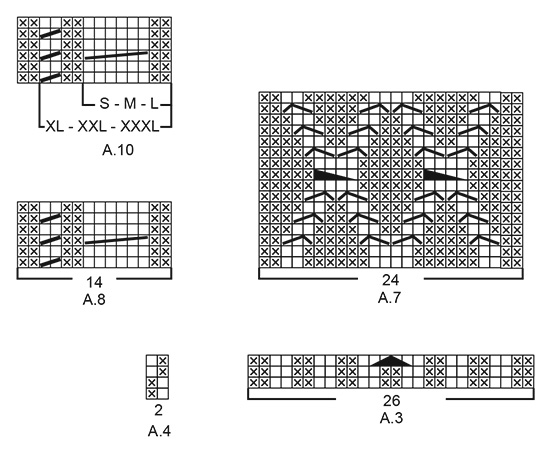 |
|||||||||||||||||||||||||||||||
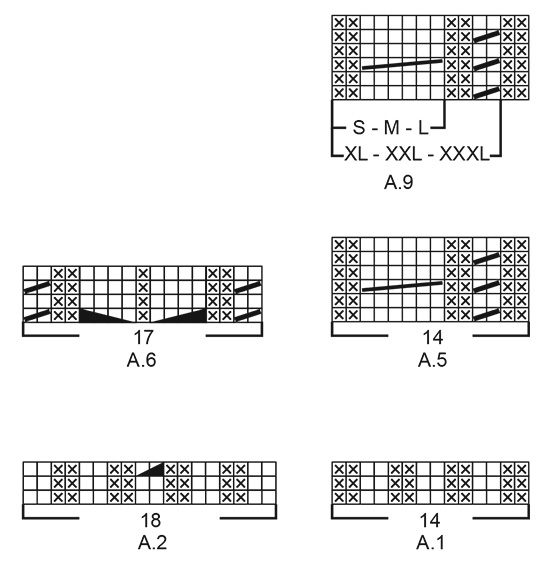 |
|||||||||||||||||||||||||||||||
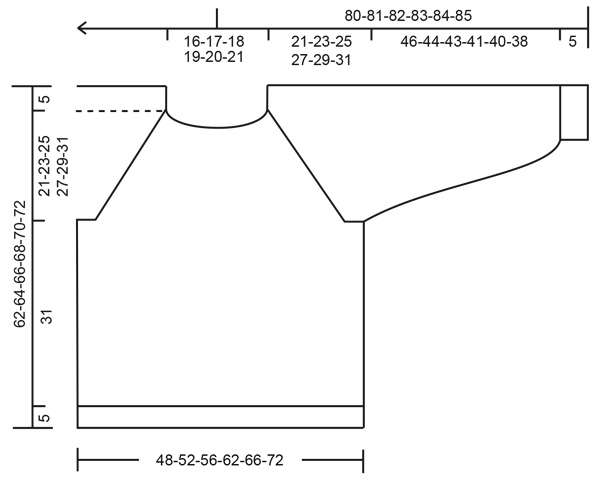 |
|||||||||||||||||||||||||||||||
Have you finished this pattern?Tag your pictures with #dropspattern #iceislandsweater or submit them to the #dropsfan gallery. Do you need help with this pattern?You'll find 28 tutorial videos, a Comments/Questions area and more by visiting the pattern on garnstudio.com. © 1982-2025 DROPS Design A/S. We reserve all rights. This document, including all its sub-sections, has copyrights. Read more about what you can do with our patterns at the bottom of each pattern on our site. |
|||||||||||||||||||||||||||||||







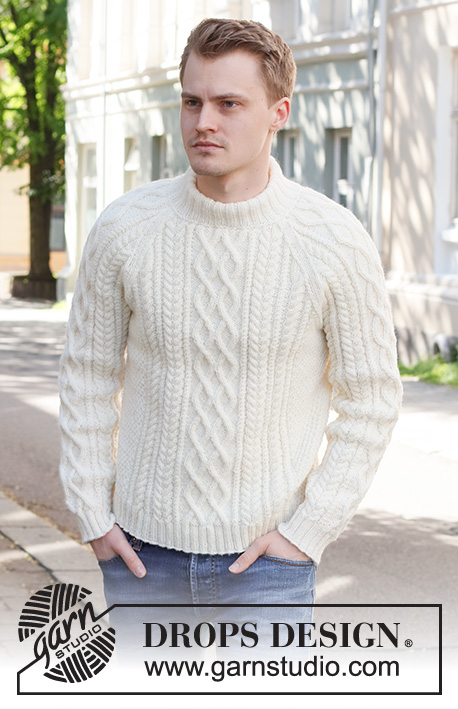
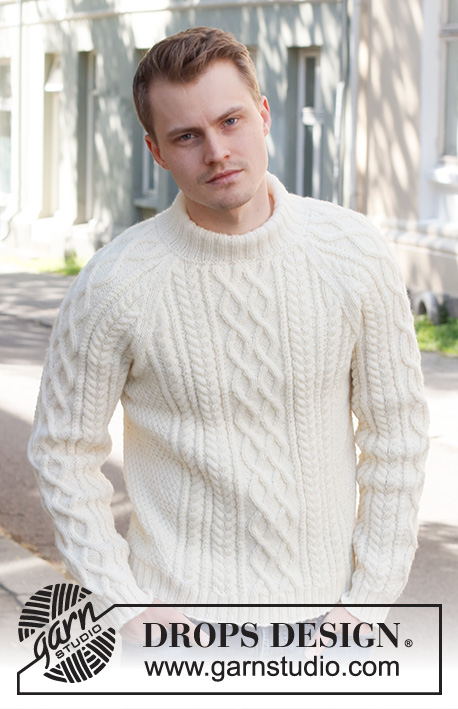
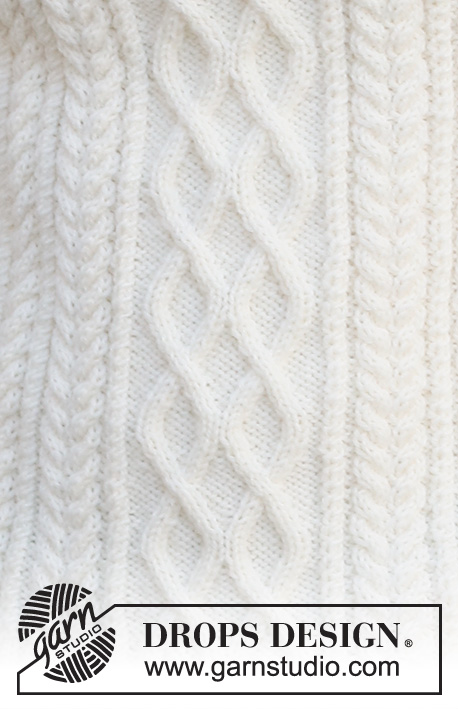


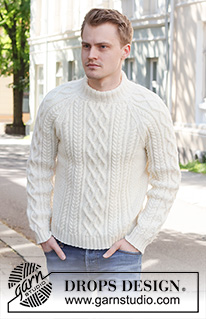
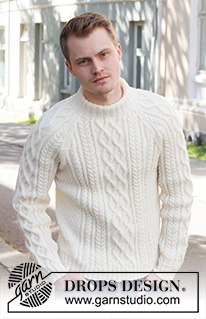
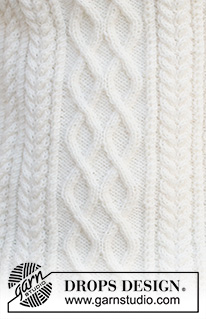

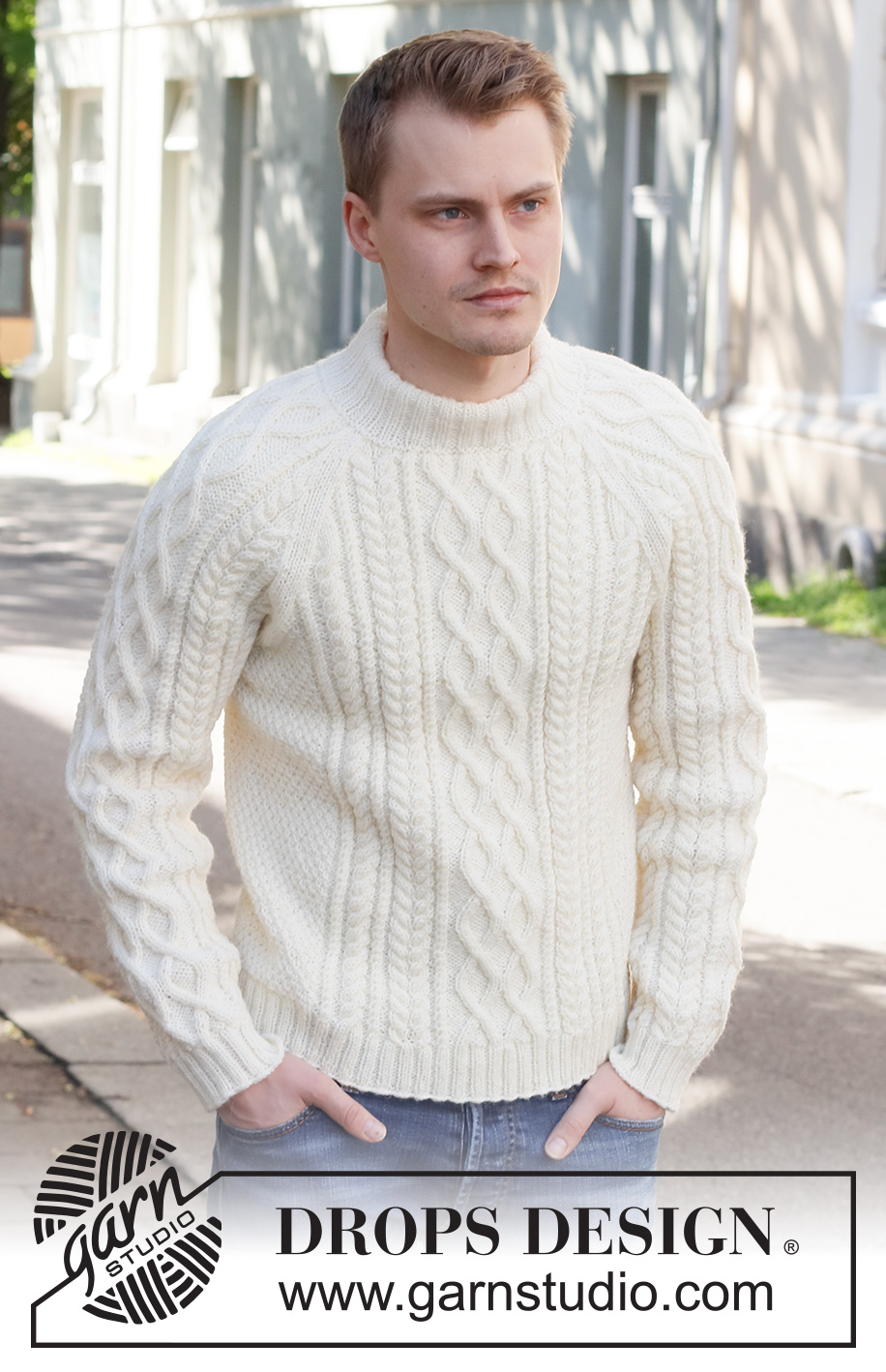
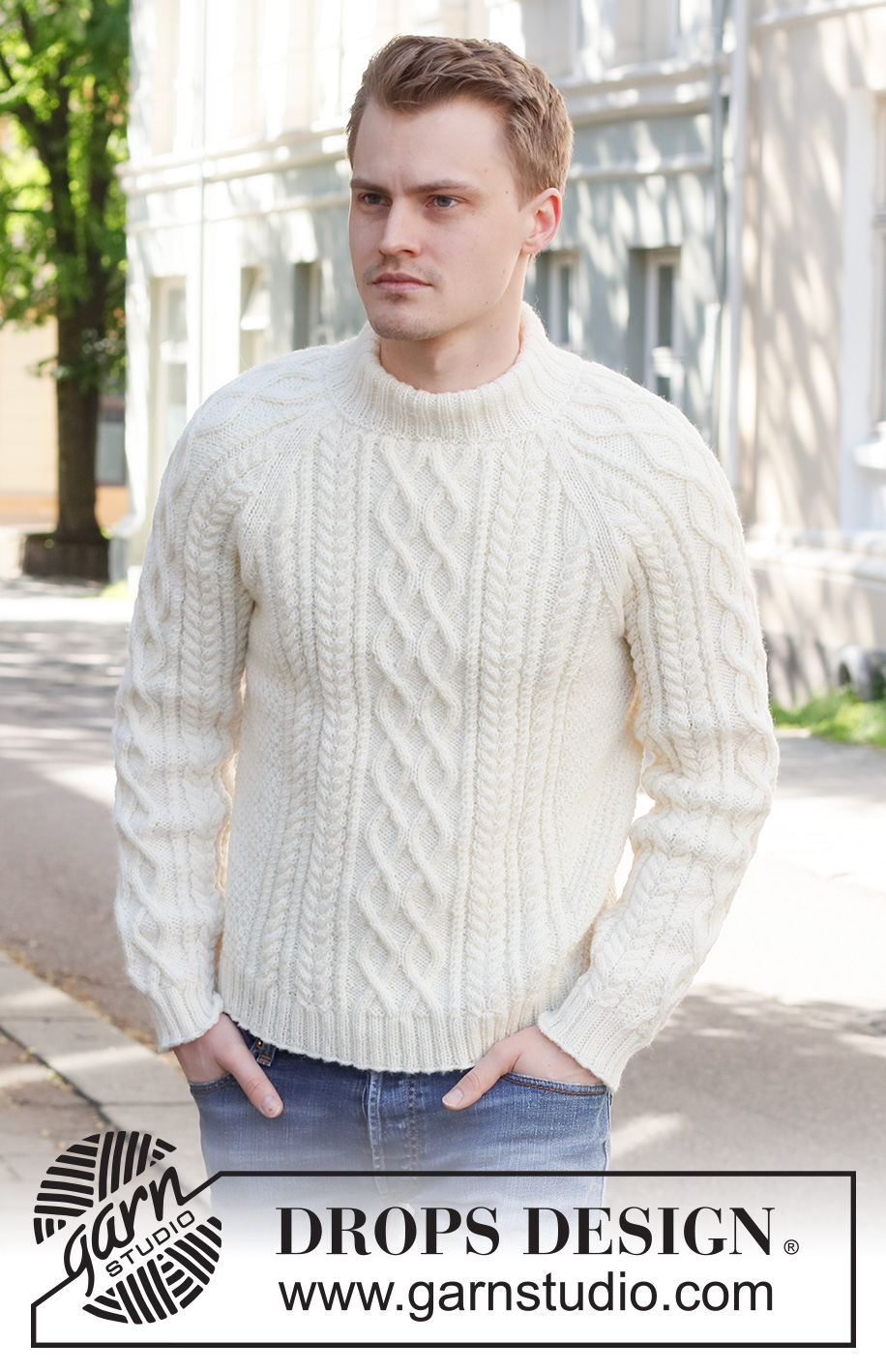
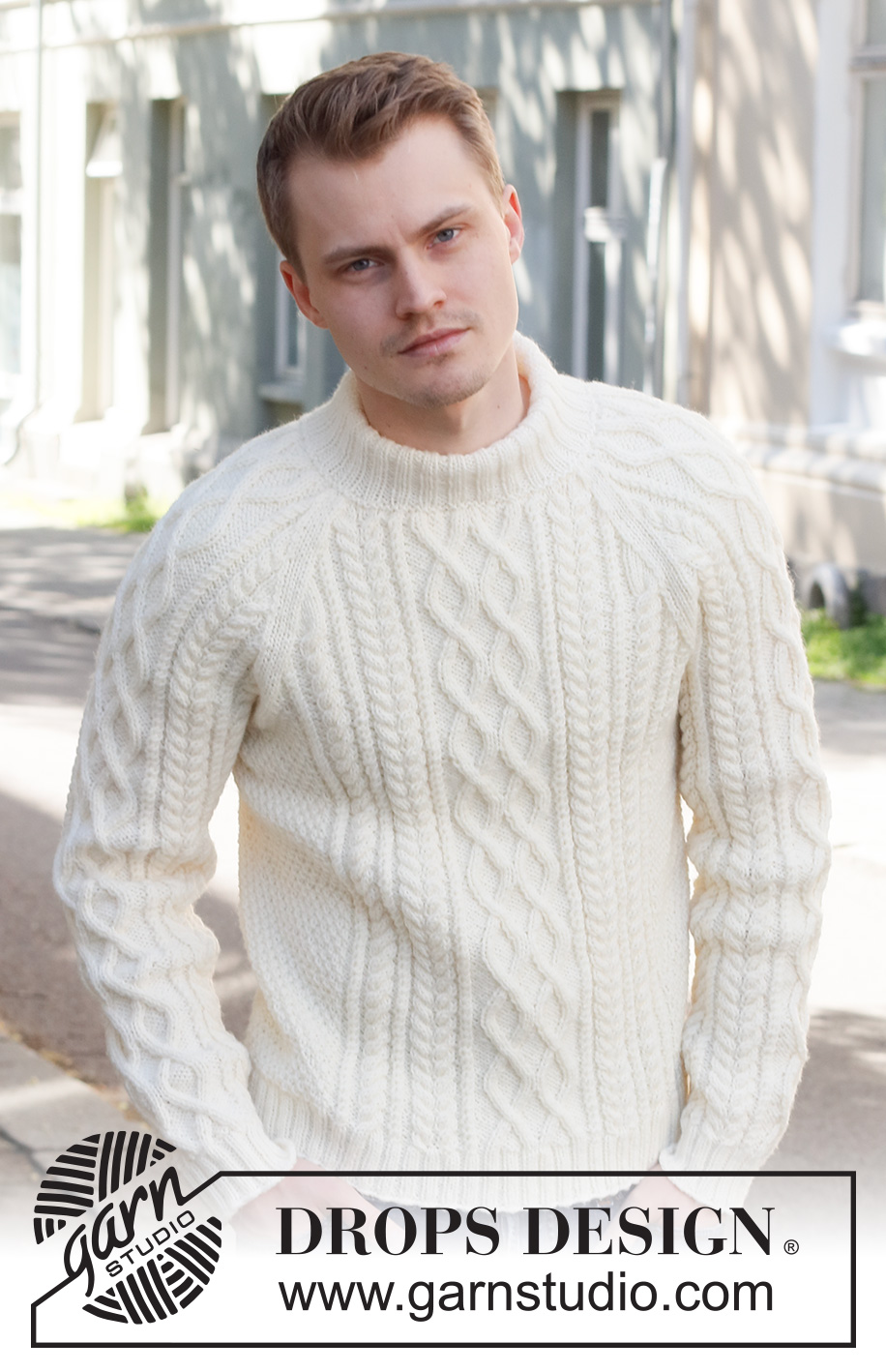


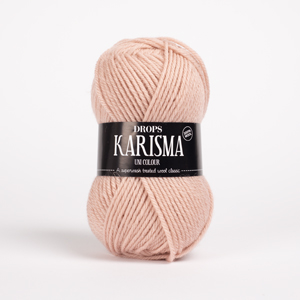



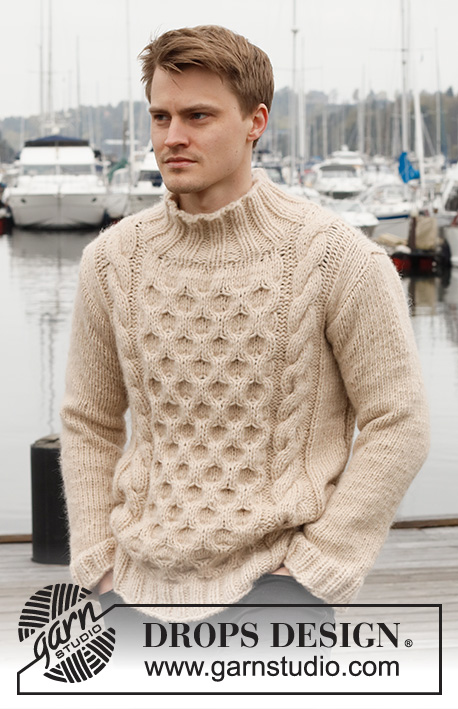
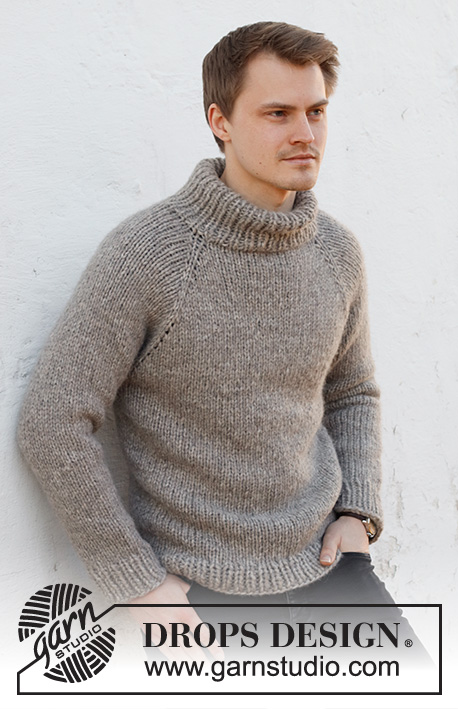


























































Post a comment to pattern DROPS 224-10
We would love to hear what you have to say about this pattern!
If you want to leave a question, please make sure you select the correct category in the form below, to speed up the answering process. Required fields are marked *.